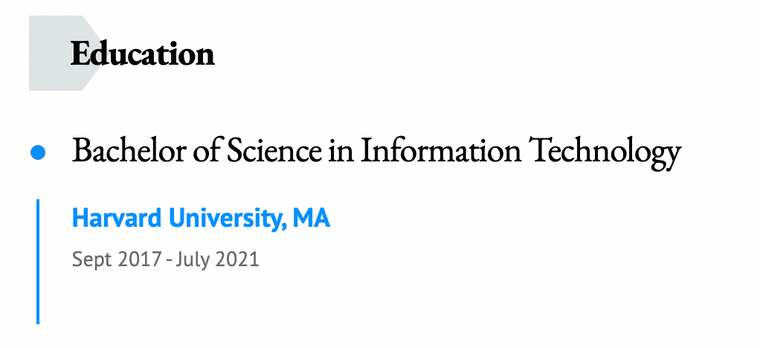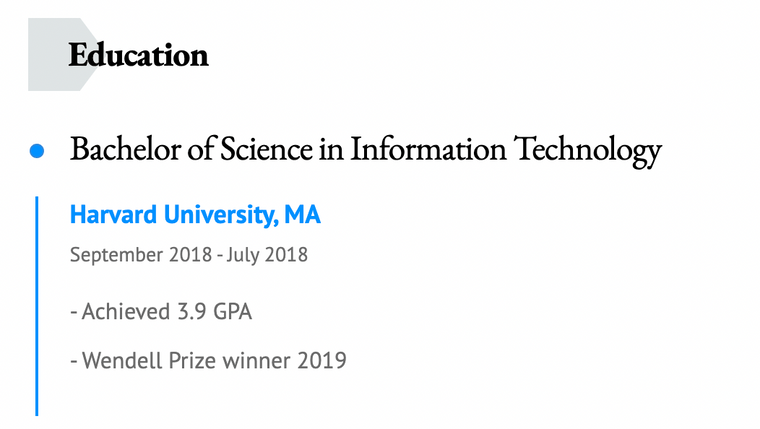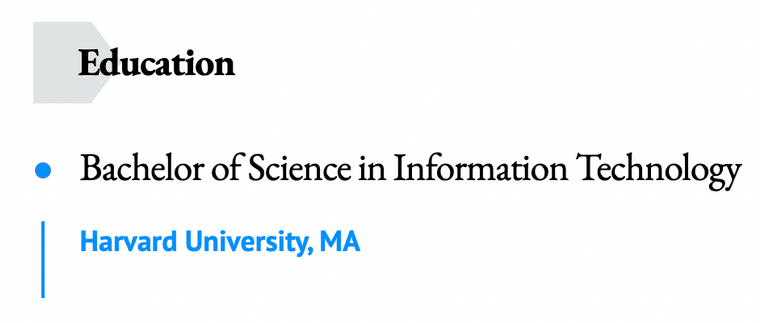Education Format in Resume: How to Display Education on a Resume
Wondering how to format your education section on your resume? Our guide to the education format in resumes will cover everything you need to know.

Here at VisualCV, we write a lot about skills and work experience, and about how to include them effectively on your resume. Both of those things are crucially important when it comes to finding the job of your dreams! But what about your education?
If you’re a little lost when it comes to finding the right education format in your resume, you’re not alone. There are a surprising number of nuances to producing a good education section, and if you’re not paying attention, it can be easy to mishandle one of your strongest assets as you draft your resume. But when it’s formatted correctly, your education section could make a real difference to your chances of landing your dream role.
That’s why we’ve put together a guide to the education section of your resume. We’ll walk you through the finer points of writing and formatting your educational background, so you can hand in your resume with confidence!
In this article, we’ll cover the following points:
- What your education section actually is
- How to design a great education section, whatever your circumstances
- Where to place the education section within your resume
- Some hints and tips on writing a great education section
What is the Education Section?
When it comes to this section of your resume, the clue is in your name! Your resume’s education section should be an overview of your relevant qualifications, education and training. Depending on your educational background and the role you’re hoping to apply for, it might include the following:
- Your high school diploma
- College or University degrees, including bachelor’s, master’s, and doctoral level degrees
- Any relevant professional certifications or licenses
Most jobs have requirements around qualifications and education, explained in each role’s individual job description. This section exists so that you can show hiring managers, at a glance, that you have the educational background they’re looking for.
In most circumstances, you won’t need to go into much detail in your education section. But you may find it useful or appropriate to include a list of key achievements alongside certain items in this section – just as you would in your work history section. It can be a helpful way to point to some extra skills or credentials, especially if your work experience is limited.
But in general, your education section can be fairly short and sweet. As long as it shows that you have the qualifications necessary for the job, you won’t need to delve into too much depth about how you got them.
How to Write Your Education Section
Wherever you are in your career journey, each listing in your education section should usually include the following information:
- Type of qualification (bachelor’s degree, state license, certification, etc)
- Field of qualification (economics, nursing, etc)
- Awarding institution (the school or professional body awarding your qualification)
- Location of institution (particularly if the institution is overseas)
- Dates of education (the month and year when you began and ended your studies)
Here’s an example of a basic listing in your education section:
Bachelor of Science in Information Technology – September 2017-July 2021 Harvard University, Massachusetts

As you can see, this listing contains all of the items on the above list! It doesn’t take up much space, but it still tells hiring managers everything they need to know.
If You’re Still in Education
If you’re still a student, you’ll need to make a few tweaks to this formula to ensure that your education section is as accurate as possible. For instance, if you haven’t finished your studies yet, you shouldn’t provide a definitive end date!
Instead, you can include the date on which you’re expected to graduate. On your resume, that could look something like this:
Bachelor of Science in Information Technology – in progress Harvard University, Massachusetts Expected to graduate July 2023

You should also read through the next section, as a lot of the advice we give to recent graduates will also be applicable to you!
Resume Education Section For Recent Graduates
If you’re a recent graduate, you probably won’t have as much work experience as a more experienced professional. That means your education section carries a lot more weight with employers. It reflects your most recent experience and your most recent opportunity to put your skills to use, so you need to treat it a little more seriously now than you will have to in the future.
As a result, you may want to include some extra information in your education section. You can do this under a subheading, so it forms part of the same listing – we usually suggest a subheading title like ‘Key Achievements,’ to call attention to your successes during your time as a student. Here are some examples of further information you can include when writing about your education:
- Your GPA (or international equivalent)
- Any scholarships or prizes you received
- Any particularly outstanding test results, provided they are relevant to the job
- Any responsibilities you held alongside your studies
And here’s an example of what that might look like in practice:
Bachelor of Science in Information Technology – September 2017-July 2021 Harvard University, Massachusetts Key achievements: Achieved 3.9 GPA Wendell Prize winner 2019

This listing paints a clear picture of academic excellence and high achievement, even to a hiring manager who is just skimming your resume! If you’re a recent graduate and you have the academic credentials, make sure you put them on display.
Resume Education Section For Experienced Professionals
If you’ve been working for a while, it’s probably safe to say that your work experience is more relevant to your skills and abilities than your education. Even if you’ve taken certifications recently, they won’t need as much in-depth attention as your recent professional experience. As a result, you can take the spotlight off your education section, and put it squarely onto your work experience instead.
This means you can make a few tweaks of your own to the basic formula of your education section. The exact dates of your education will be less relevant, now, so you can remove them without worrying too much. Likewise, any prizes or results you achieved in school will be much less significant than your more recent achievements at work – so you can leave them off, freeing up space to use in your work experience section instead.
Here’s what that will look like on your resume:
Bachelor of Science in Information Technology Harvard University, Massachusetts

Believe it or not, that’s all you need! Your work history section should be doing the hard work, at this stage in your career. Your education section is a way to give yourself a competitive edge, but it shouldn’t be the focal point of your resume.
Useful Words and Phrases for the Education Section
When writing your work experience section, it’s smart to use dynamic, impactful words and phrases to describe your experience. The same is true when you’re writing about your education! Particularly in the early stages of your career, this section of your resume might be doing a lot of work to make up for your limited work experience – so you should treat it similarly, and make sure it really speaks to the effort and time you spent on your education.
Not sure where to start? Here are some useful words and phrases that can help you make your education section sing!
Achieved
It might seem obvious that you should refer to your achievements as what they are! But ‘achieved,’ as a verb, implies effort, work, and time. Talking up your achievements on your resume will show an employer that you’re capable of going beyond the bare minimum for the sake of a goal, which will reflect well on you as a candidate.
Maintained
Writing about what you achieved will show that you went above and beyond – but writing that you ‘maintained’ a GPA, or a certain number of classes in your schedule, will show consistency. It’s an underrated quality, but one that is considered vital in many fields. Being able to show that you can keep your performance at a consistently high level will be a huge asset to you in the world of work.
Pursued
This one implies a level of drive and determination that should encourage any hiring manager! Being able to say that you ‘pursued’ an extracurricular activity or an extra class will imply that you really sought it out – which will reflect well on your ability to take ownership of your professional development in the future.
Where Should the Education Section Go?
The order of your resume will depend on a number of factors. It might be influenced by the requirements of the job you’re applying for – for instance, if it needs a particular qualification, you should make sure that qualification is easy for a hiring manager to spot. But in general, there’s a fairly clear rubric for where to place your education section within your larger resume.
You should put the education section ahead of your work history section only if you are a current student or recent graduate, with a limited level of work experience. This ensures that hiring managers will notice your education section (which should be fairly thorough!) before they see your limited level of work experience. They’ll come away with a better first impression of you as a candidate.
You should put the education section after your work history section under most other circumstances. If you have a substantial amount of work experience, that should always take priority over your education section – purely because it’s much more likely to be relevant to the job than your education. As we’ve explained, your education section is a bonus feature in this scenario, rather than the main event.
Designing Your Education Section
Choosing the right resume template will help you to design a great education section. Check out VisualCV’s amazing range of professionally-designed free templates, if you haven’t already! There are templates available to suit everyone, wherever you are in your career journey.
Look for a template that gives your educational background the right amount of focus for your personal circumstances. If you’ve been a working professional for a while, you may want to look for a template that moves your education section into a narrower column. That way, you’ll free up more space in the main body of your resume for the work experience section – which, as we’ve explained, should be the focal point of your resume at this stage in your career.
On the other hand, if you’re still in education or you’ve just recently left it, you should find and use a template that draws attention to your education section. It should have enough room for you to include your achievements, which means it should be part of the main body of your resume. That way, you can give it the weight and focus it needs until your work experience section is strong enough to support itself.
Copyright ©2025 Workstory Inc.